
“Deine Vorfahren zu vergessen bedeutet, ein Fluss ohne Quelle zu sein, ein Baum ohne Wurzel.”
“Forgetting your ancestors is to be a river without a source. A tree without a root.”
Palatinate and Palatines
“War and persecution left the German Protestants of the Palatanate in Germany in a destitute situation. Soon after 1700 they began to turn their hopes toward the ‘New World,’ America.” -from Historic Sketch of the Reformed Church in North Carolina.

The Palatinate is a region in southwest Germany that borders France. The Germans from this region, many of them farmers and vineyard operators, who emigrated to America at the start of the 18th Century were collectively called Palatines by ship captains and customs officials and merchants during their emigration to the British Colonies. Most of the Palatines belonged to the main Lutheran and Reformed churches. As many as half of the Palatines arrived in the British Colonies as redemptioners. These were Palatines who agreed to work in the Colonies in exchange for free passage across the Atlantic Ocean. What the Palatines left behind were physical and mental remnants of previous political and religious wars, heavy taxation, a lack of available land, and likely a fear of perpetual instability in the region. What they were offered in the British Colonies was a greater degree of independence and control over their land and their lives . A “better life,” which was encouraged at that time by the British government.
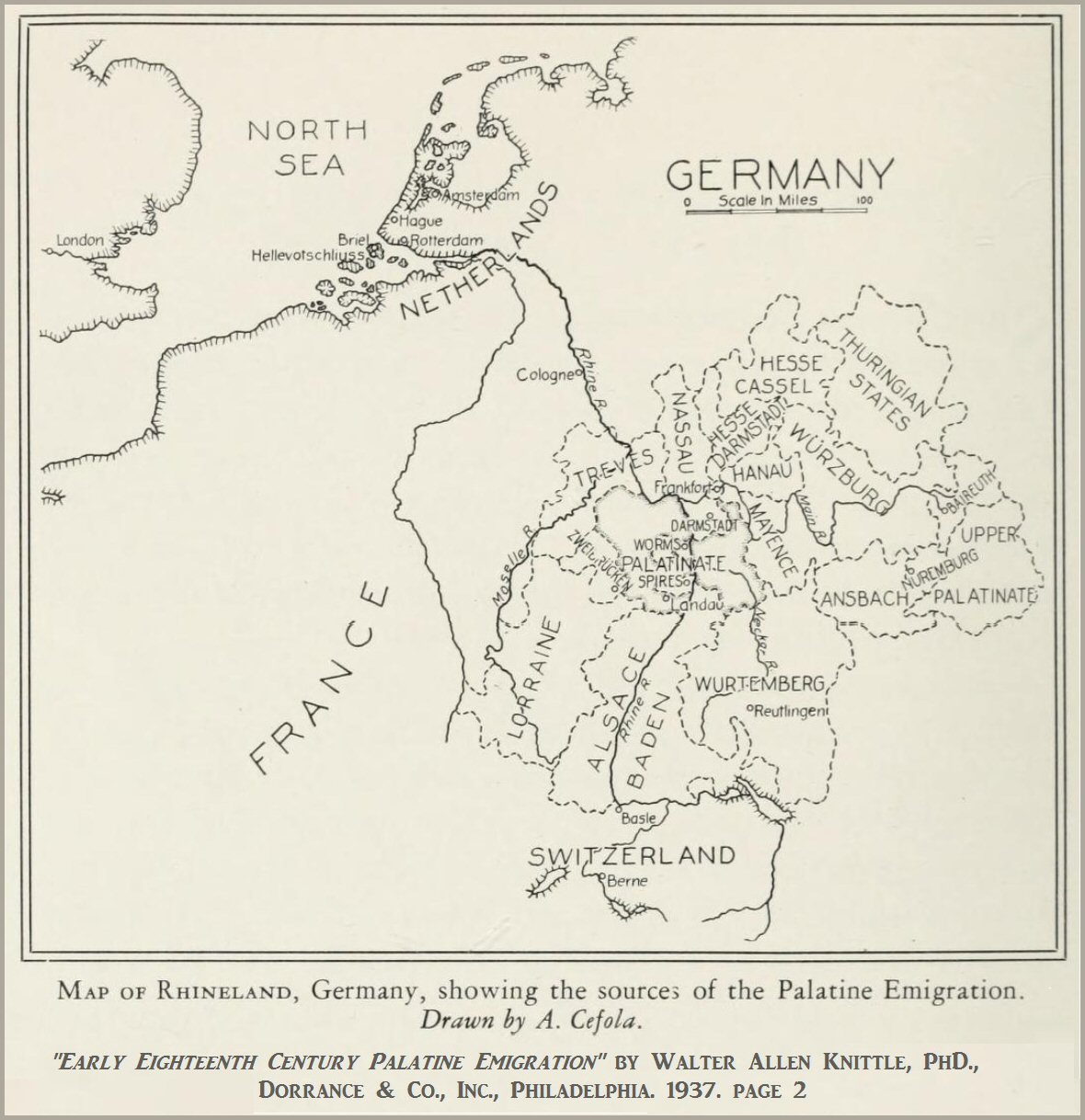
It has been written that in 1708 Hans Ulrich (Uhlerick) Fritz was born in Dettingen, Baden-Wurttemberg. Dettingen was a primarily Lutheran village located in the Ermes Valley about 50 miles south of Stuttgart in southwest Germany. 1708 was also the year that the harshest winter in 100 years devastated the people and the land of the Palatinate. For some Palatines the “Winter of 1708-09,” as it came to be known, was the final straw. At the invitation of Queen Anne in the spring of 1709, about three-thousand demoralized and discontented Palatines left their ancestral homelands and sailed for the British Colonies. In 1738 Hans Ulrich Fritz and his young son Woolrich Frederick Fritz did likewise.
1738 : Down the River to Rotterdam
By 1738 the emigration patterns had changed. British merchant ships were regularly arriving in Rotterdam and Amsterdam from the colonies with colonial staples. Rather than return to the Colonies empty, the shipping companies made their ships available for “human cargo,” or individuals and families who were wanting to visit or relocate to the British Colonies.
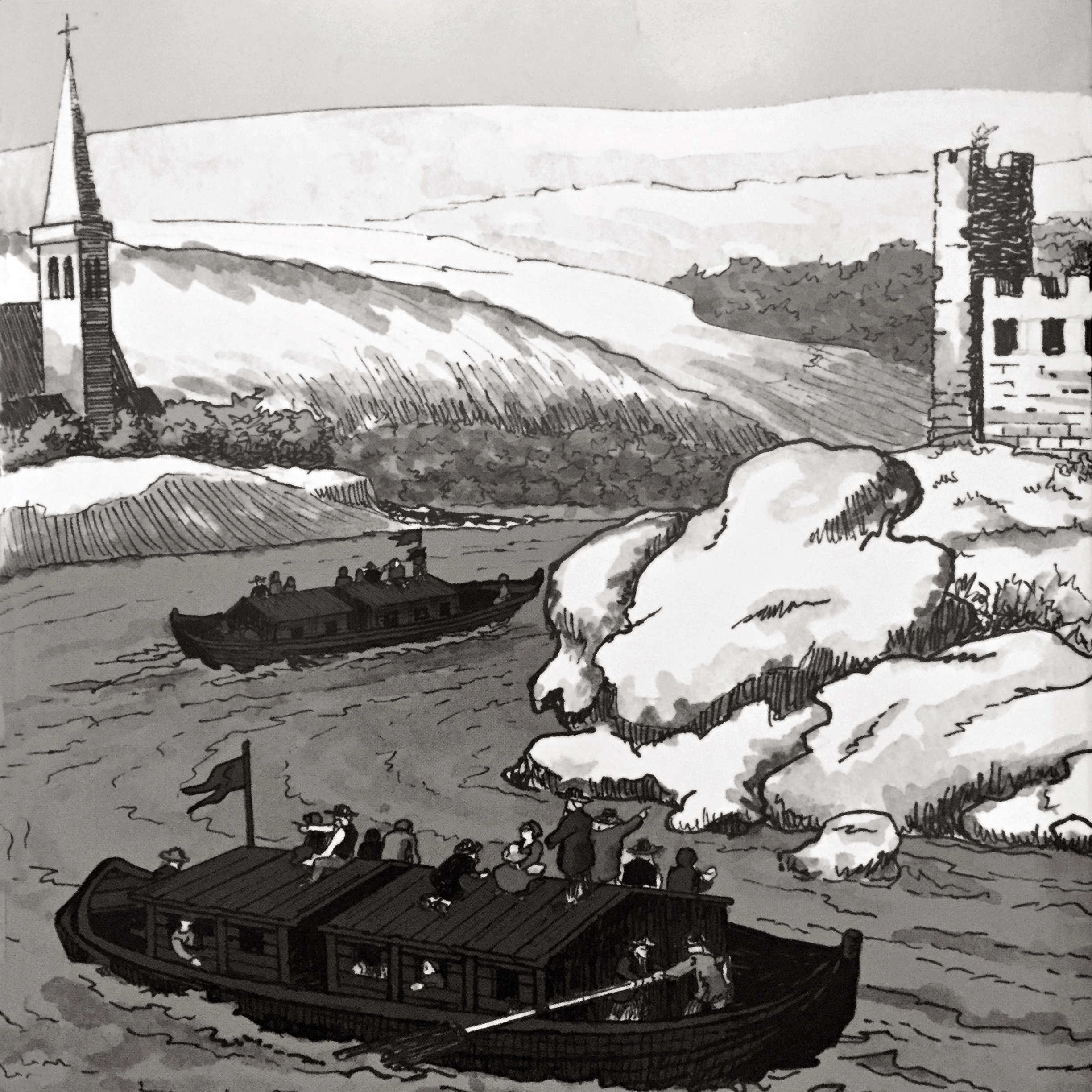
Around March of 1738 Hans Ulrich Fritz, along with his son and other members from surrounding communities loaded themselves and some personal belongings into river boats and left their homeland. The Palatines floated toward Rotterdam, likely via the Erms and Rhine rivers. There were often setbacks and delays along the way including principality fees and tolls. Some of the delays were purposefully done by petty officials to benefit local shops and innkeepers. The journey took between four and six weeks and in many cases the Palatines arrived in Rotterdam in April with no money to pay for their ocean transportation to the Colonies. In these cases passengers could sell some of the goods they had brought with them or have a family member living in the colonies pay for the cost of passage once they arrived. Another option was paying for passage through redemption. The last option involved the passenger signing a contract to pay their fares within a designated time after arrival.

The ships that would take the Palatines to America were not yet in Rotterdam when they reached the area in April 1738. The Rotterdam city authorities prohibited Rhine shippers from unloading Palatines and other foreigners within the city limits out of concern for rampant disease and dysentery. Instead they were to take them to a holding area in the vicinity of the ruins of St. Elbrecht’s chapel below Kralingen. On May 13th the bailiff and court of Kralingen petitioned the States of Holland to have the Palatines either sent back to their homelands or quickly taken to America. The objective was to get the Palatine on their way as their stay in the holding area would likely lead to an epidemic. In fact the outbreak of dysentery and acute fevers had already resulted in nearly 80 small children dying within a very short period of time.
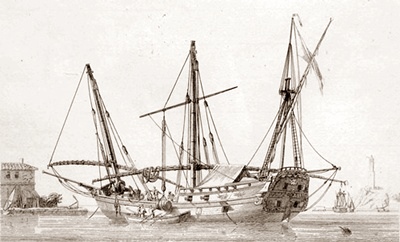
Soon the British shipping merchants of Rotterdam made their preparations and then summoned additional ships from English ports to augment the regular fleet of emigrant ships. The major shipping firm Hope readied eight ships, some from their fleet and others chartered. Once the ships became available, they had to be hastily fitted with additional bedsteads to handle the amount of passengers. Some were double bedsteads and others three on top of one another. Many passengers had their luggage chests broken up and stored their belongings wherever room was available. They would otherwise have to leave items behind to be sent later by other ships. Many items were lost to rot and moths.
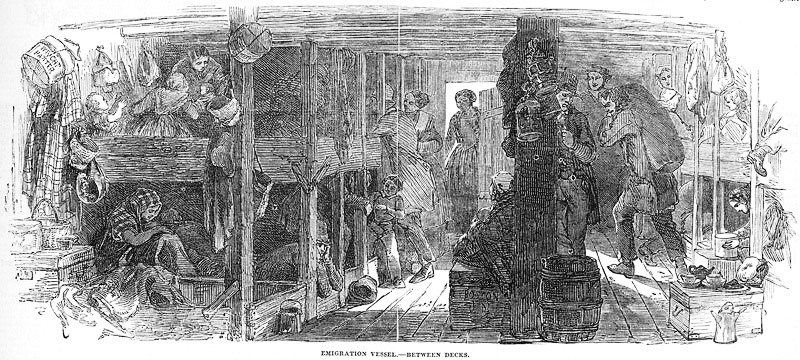
From Goeree to Cowes
In June 1738 the first ships were ready for loading. The sailing ships varied in size with the larger ships being about 99 feet in length, 26 feet in breadth, with a 311 ton capacity. The people were assigned to the ships with 100 in some, 200 in others, and in some cases 400 or more. One ship’s list noted as many as 480 passengers. In most ships the people were packed tightly below deck and whatever belongings they brought filled any available space. Hans Ulrich and his son Woolrich boarded the ship Elizabeth. The captain of the Elizabeth was George Hodgson. Once the ships were loaded the fleet began the process of crossing over to England for customs clearance in accordance with the Navigation Acts. The Elizabeth sailed out of Goeree, a port on the North Sea near Rotterdam, on July 18th. The fleet slowly made their way to Cowes on the Isle of Wight where ship inspections were to be completed. A violent storm played havoc with the heavily loaded ships and it took between 3 to 5 weeks for the ships to reach Cowes.
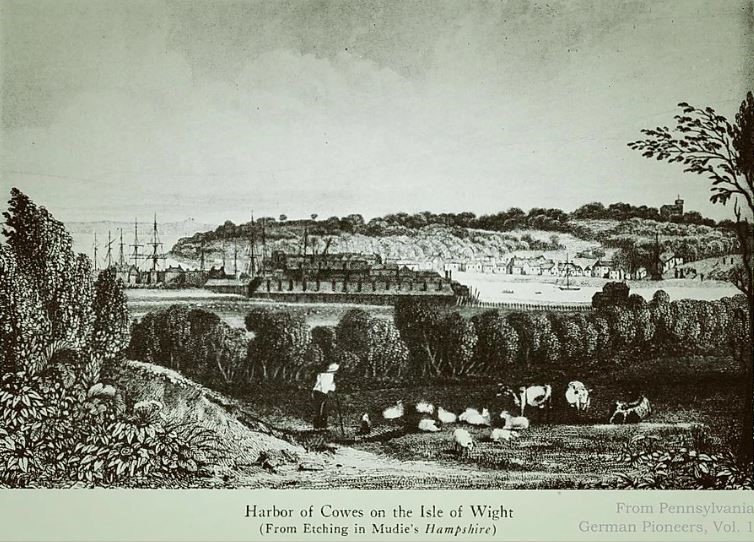
The Collector of Customs at Cowes in 1738 was a man named Newland Reynolds, a merchant on the Isle of Wight. While a ship was detained for inspection at Cowes the passengers were allowed to go ashore via a ship’s longboat or by fisherman who offered ferry services, for a price. West Cowes was then a “town” of about 1300 people. The town itself was made from discarded ship timbers and cow dung which contrasted the beautiful residential gardens that got the attention of many travelers. The town also offered several shops and taverns. The stop was a pleasant one according to the journals of Palatines that passed through on their way to America. Once the customs inspections were completed, preparations were made for the Atlantic crossing. When the passengers were back on board the ship’s captain waited for the right tide and the right wind to take the ship out of the Solent Strait and into the English Channel. After a day or two the ship passed the “Lizard,” a rocky peninsula that marked the southernmost point of the British mainland. The Lizard was the last of Europe that most of the emigrants would ever see as they made their way out into the Atlantic where the sapphire waters gradually turned to a navy blue and then abruptly to black as the sea floor dropped away to unfathomable depths.
Waves Like Mountains : Crossing the Atlantic

The voyage across the Atlantic varied from two to six months, depending on wind and weather. The 1934 publication Pennsylvania German Pioneers provides a description of the Atlantic journey:
“The third stage of the journey, or the ocean voyage proper, was marked by much suffering and hardship. The passengers being packed densely, like herrings, without proper food and water, were soon subject to all sorts of diseases, such as dysentery, scurvy, typhoid and smallpox. Children were the first to be attacked and died in large numbers. Mittelberger reports the deaths of thirty-two children on his ship. Of the heartless cruelty practised he gives the following example; “One day, just as we had a heavy gale, a woman in our ship, who was to give birth and could not under the circumstances of the storm, was pushed through the porthole and dropped into the sea, because she was far in the rear of the ship and could not be brought forward.
The terrors of disease, brought about to a large extent by poor food and lack of good drinking water, were much aggravated by frequent storms through which ships and passengers had to pass. The misery reaches the climax when a gale rages for two or three nights and days, so that everyone believes that the ship will go to the bottom with all human beings on board. In such a visitation the people cry and pray most piteously. When in such a .gale the sea rages and surges, so that the waves rise often like mountains one above the other, and often tumble over the ship, so that one fears to go down with the ship; when the ship is constantly tossed from side to side by the storm and waves, so that no one can either walk, or sit, or lie, and the closely packed people in the berths are thereby tumbled over each other, both the sick and the well — it will be readily understood that many of these people, none of whom had been prepared for hardships, suffer so terribly from them that they do not survive. When at last the Delaware River was reached and the City of Brotherly Love hove in sight, where all their miseries were to end, another delay occurred. A health officer visited the ship and, if any persons with infectious diseases were discovered on the ship, it was ordered to remove one mile from the city.”
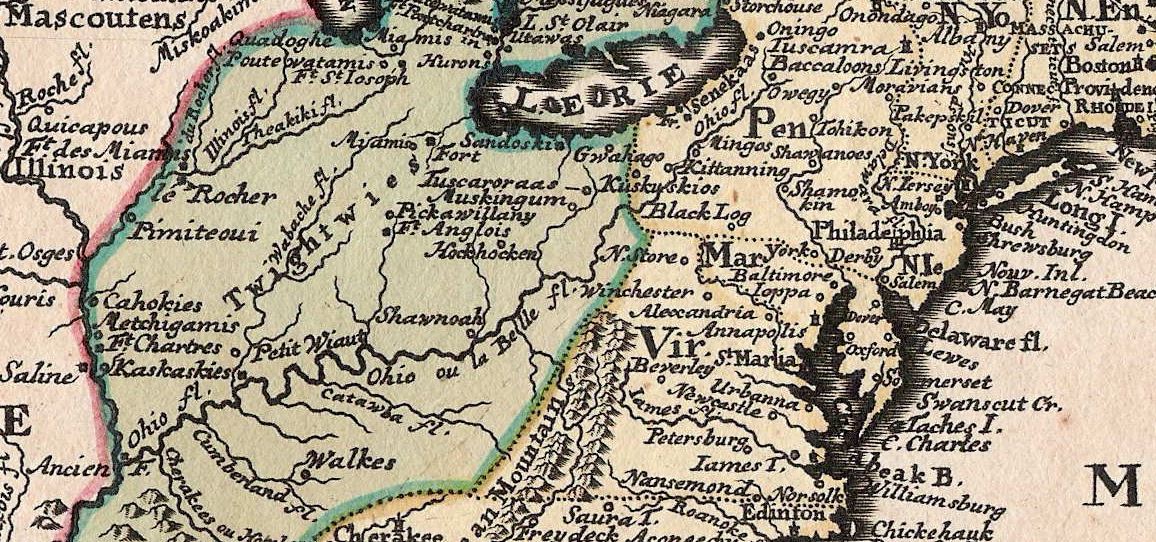
The same 1934 publication also provides an account of the arrival of passenger ships into the harbor of Philadelphia.
“After much delay one ship after another arrives in the harbor of Philadelphia, when the rough and severe winter is before the door. One or more merchants receive the lists of the freights and the agreement which the emigrants have signed with their own hand in Holland, together with the bills for their travel down the Rhine and the advances of the ‘new- landers’ for provisions, which they received on the ships on account. Formerly the freight for a single person was six to ten louis d’ors, but now it amounts to fourteen to seventeen louis d’ors. Before the ship is allowed to cast anchor at the harbor front, the passengers are all examined, according to the law in force, by a physician, as to whether any contagious disease exists among them. Then the new arrivals [specifically men 16 years and older] are led in procession to the City Hall and there they must render the oath of allegiance to the king of Great Britain. After that they are brought back to the ship. Then announcements are printed in the newspapers, stating how many of the new arrivals are to be sold. Those who have money are released. Whoever has well-to-do friends seeks a loan from them to pay the passage, but there are only a few who succeed. The ship becomes the market-place. The buyers make their choice among the arrivals and bargain with them for a certain number of years and days. They then take them to the merchant, pay their passage and their other debts and receive from the government authorities a written document, which makes the newcomers their property for a definite period.When we examine the dates of arrival of the ships, we note that the large majority of them arrived in the fall. In Au- gust twenty-nine, in September one hundred and thirty-eight, in October eighty-six, in November thirty-three and in December fourteen. In none of the other months did the totals exceed five ships for each month. Muehlenberg was, therefore, entirely correct when he stated that most of the ships reached Philadelphia when the hardships of winter were staring the newcomers in the face.”
Another great description of the voyage across the Atlantic is provided by Jill Farinelli in her book The Palatine Wreck: The Legend of the New England Ghost Ship, particularly Chapter Six.
Philadelphia
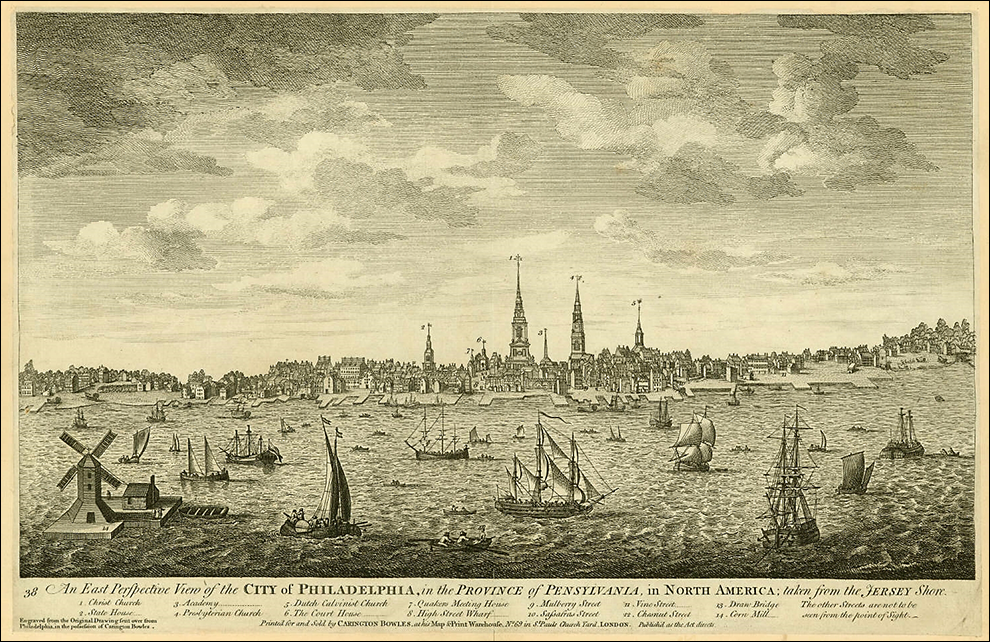
The first ship to arrive at Philadelphia on September 5th was the Winter Galley. Other ships followed throughout the following months. The ship Elizabeth arrived at the harbor of Philadelphia in late October. The 95 passengers qualified (landed) in Philadelphia on October 30, 1738. Hans Ulrich along with all men 16 years or older were taken ashore and led to the City Hall where they took the Oaths to the Government.

Present at this oath taking was The Philadelphia Mayor Anthony Morris and former Mayors William Allen and Clement Plumsted. The Oaths were as follows:
Declaration of Allegiance
“We Subscribers, Natives and Late Inhabitants of the Pala- tinate upon the Rhine & Places adjacent, having transported ourselves and Families into this Province of Pennsylvania, a Colony subject to the Crown of Great Britain, in hopes and Expectation of finding a Retreat & peaceable Settlement therein. Do Solemnly promise & Engage, that We will be faithful & bear true Allegiance to his present MAJESTY KING GEORGE TFIE SECOND, and his Successors, Kings of Great Britain, and will be faithful to the Proprietor of this Province; And that we will demean ourselves peaceably to all His said Majesty’s Subjects, and strictly observe & con- form to the Laws of England and of this Province, to the utmost of our Power and best of our understanding.”
Beginning with August 19, 1729, the immigrants were also required to sign two additional declarations. These were:
“I A B do solemnly & sincerely promise & declare that I will be true & faithful to King George the Second and do solemnly sincerely and truly Profess Testifie & Declare that I do from my Heart abhor, detest & renounce as impious & heretical that wicked Doctrine & Position that Princes Excom- municated or deprived by the Pope or any Authority of the See of Rome may be deposed or murthered by their Subjects or any other whatsoever. And I do declare that no Forreign Prince Person Prelate State or Potentate hath or ought to have any Power Jurisdiction Superiority Preeminence or Authority Ecclesiastical or Spiritual within the Realm of Great Britain or the Dominions thereunto belonging.”
And:
“I A B do solemnly sincerely and truly acknowledge profess testify & declare that King George the Second is lawful & rightful King of the Realm of Great Britain & of all others his Dominions & Countries thereunto belonging, And I do solemnly & sincerely declare that I do believe the Person pretending to be Prince of Wales during the Life of the late King James, and since his Decease pretending to be & taking upon himself the Stile & Title of King of England by the Name of James the third, or of Scotland by the Name of James the Eighth or the Stile & Title of King of Great Britain hath not any Right or Title whatsoever to the Crown of the Realm of Great Britain, nor any other the Dominions thereunto belonging. And I do renounce & refuse any Allegiance or obedience to him & do solemnly promise that I will be true and faithful, & bear true allegiance to King George the Sec- ond & to him will be faithful against all traiterous Con- spiracies & attempts whatsoever which shall be made against his Person Crown & Dignity & I will do my best Endeavours to disclose & make known to King George the Second & his Successors all Treasons and traiterous Conspiracies which I shall Know to be made against him or any of them. And I will be true & faithful to the Succession of the Crown against him the said James & all other Persons whatsoever as the same is & stands settled by An Act Entituled An Act declaring the Rights & Liberties of the Subject & settling the Succession of the Crown to the late Queen Anne & the Heirs of her Body being Protestants, and as the same by one other Act Entituled An Act for the further Limitation of the Crown & better securing the Rights & Liberties of the subject is & stands settled & entailed after the Decease of the said late Queen, & for Default of Issue of the said late Queen, to the late Princess Sophia Electoress & Dutchess Dowager of Han- nover & the Heirs of her Body being Protestants; and all these things I do plainly & sincerely acknowledge promise & declare according to these express Words by me spoken & according to the plain & common Sense and understanding of the same Words, without any Equivocation mental Evasion or secret Reservation whatsoever. And I do make this Recognition Acknowledgement Renunciation & Promise heartily willingly & truly.”
Klaus Wust noted in his 1998 article “1738: The Year of the Destroying Angels.” how passengers were typically received at Philadelphia.
“As usual during the arrival season, Germans, some even from remote settlements, crowded the harbor to greet relatives, friends, or just people from their old home place to hear news and maybe find mail.”
After taking his Oaths in Philadelphia’s City Hall, Hans would have been taken back to the ship Elizabeth to get his son and gather their things. They were then taken to shore. There’s no record of Hans purchasing land. It is assumed then that Hans arrived with very little money and likely had to rely on the Redemption system for some stretch of time and likely did so in Pennsylvania or perhaps the Shenandoah Valley in Virginia.
Shenandoah Valley – Virginia

An Augusta County court record in Virginia provides some evidence that between 1738 and 1759 Woolrich had made his way to the Shenandoah Valley to work for William McGee. The court records note on March 21,1759 that McGee was “summoned to pay freedom dues to his late servant, Frederick Frits.” The record also states, “Same as to Janet Frits,” who Woolrich must have married by that time. It has been suggested they were married in 1752, in Virginia. It’s assumed that Woolrich and his wife Janet indentured themselves to obtain money in order to establish the Fritz family in the Shenandoah Valley. Three children were born while the family was living in Virginia. They were George (1753), Mary (1754) and John(1762).
After the birth of John in 1762 and before the birth of another daughter Susanna in 1765 Woolrich and Janet moved the family down to Lexington, North Carolina (Rowan County). The trip from the Shenandoah Valley by way of the “Great Philadelphia Wagon Road” that led into the wilderness of North Carolina could take from “10 days to two weeks, with the constant danger of Indians, floods and wild animals.”

Rowan County was formed in 1753. In the 1881 publication, A History of Rowan County, the author notes that:
“The earliest settlements in Rowan of which we have any accurate knowledge were made about 1737. Dr. Foote, in his Sketches of North Carolina, states that the Scotch-Irish began their settlements in Shenandoah Valley in Virginia in 1737, and in North Carolina soon afterwards. But along with these Scotch-Irish immigrants, and settling side by side with them, there came settlers of another nationality to whom Rowan is no less indebted for her material wealth and prosperity. These were the Germans, or as they were familiarly called the “Pennsylvania Dutch.” They were of course not of Dutch or Holland extraction, but Germans from the Palatinate, and from Hessen Cassel, Hessen Homburg, Darmstadt, and the general region of the upper and middle Rhine. The first arrival of Germans in Western North Carolina,in the bounds of Old Rowan, is believed to have taken place about 1745, though it was five years later that the great body of them came. The stream thus started and continued to flow on for years, many of them arriving after the Revolutionary war. They traveled with their household goods and the women and children in wagons, the men and boys walking and driving their cattle and hogs before them. They came side by side with their Scotch-Irish neighbors…”
Rowan County – North Carolina Colony

When Woolrich arrived in North Carolina with his family they settled on land near one of the first German settlers of the region Valentine Leonard. Leonard arrived in Rowan from the Palatinate in about 1746 and was living on a large tract of land located on the waters of Abbotts Creek and one of its tributaries, near Lexington. The publication “First Church of Davidson County: A History of Pilgrim Evangelical and Reformed Church” provides some insight into the Germans that settled the area:
“It was from Germany and Pennsylvania that the first settlers of Forsyth, Davidson, and Rowan Counties came. They came in families, and singularly; they came young and old; they came, to live and to die; here in a new land in new homes. They cleared land, built crude homes, and began to make a way of life for themselves and their families. These settlers were Germans, speaking German, reading German and coming from German Churches; that is, Lutheran, Reformed, or Moravian. It is safe to conclude that a majority of the first settlers along Abbott’s Creek were Reformed, for the first Church they erected was a Reformed Church. With them they had brought their Bibles, Hymnals and Catachesims, but there were no ministers nor teachers available. There were no Church buildings.”
Around 1753 the first settlers decided that a place of worship was needed. A spot near a spring was selected among a grove of oak, hickory and maple trees about three miles from Abbotts Creek. Soon after a crude shelter known as a brush arbor was constructed. This location became the first place of worship for the early settlers in Davidson County and the area surrounding it, the burial grounds of their relatives. The “church” was soon referred to as Leonard’s Church. In the “Records of the Moravians In North Carolina” it was referred to as the “Abbott’s Creek Church.”
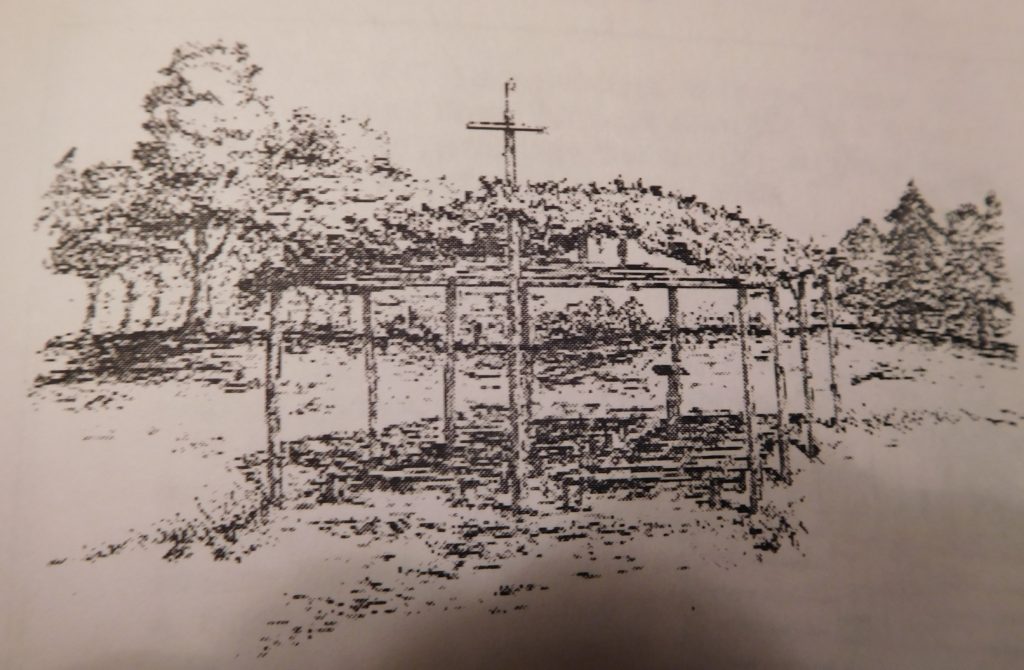
The brush arbor location worked well enough for the settlers for some time, however, between 1759 and 1764 the first church building was constructed. This church was built of large logs and stood on an elevated spot at the north-east corner of the cemetery. It was built with a gallery at each end and on one side, while the other side was occupied by a tall wineglass pulpit. The name of the church was The Church of the Pilgrims, or Pilgrims Church.
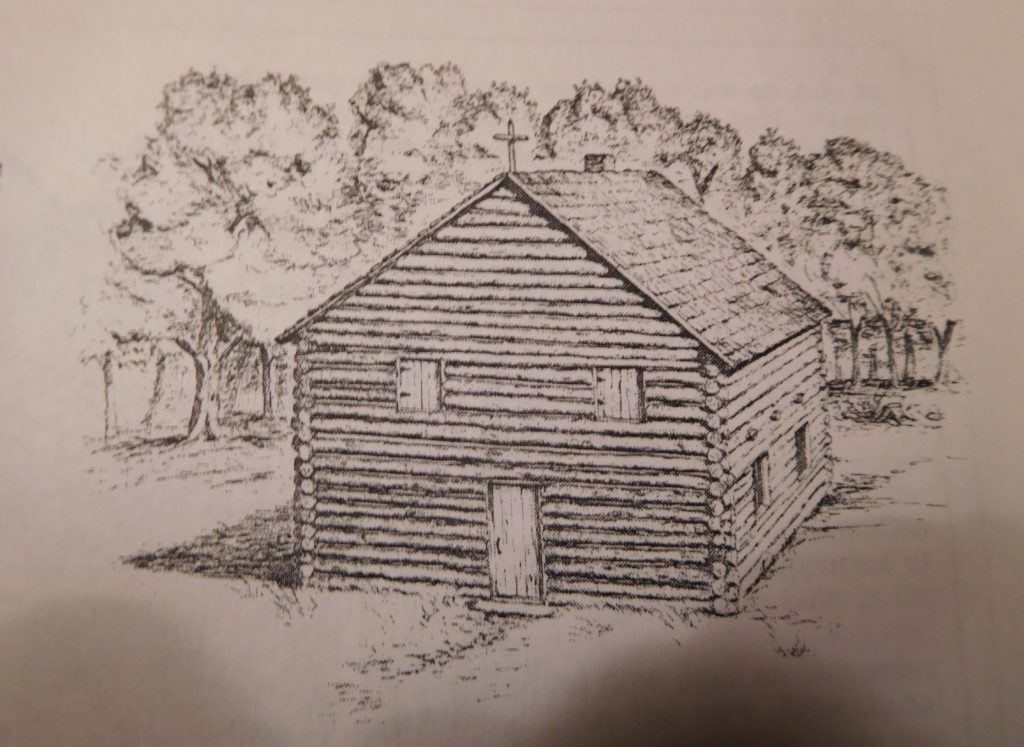
Either Rev. James Martin or Richard Dupert, both Swiss Reformed ministers, was pastor of the Pilgrim Church when Woolrich arrived around 1763. Ancestry writings have suggested that Woolrich became a member of the Pilgrim Church. Although Woolrich may not have known some of the Rowan settlers personally from the Palatinate or his days in Pennsylvania and Virginia, he likely knew their family names from “back home” and I suspect he felt quite welcome. A 1760 map representing the area around Pilgrim Church that had been updated with landmarks shows a tract of land bordered by Highway 29, Old US 29, Old Greensboro Road, and Rich Fork creek. On that tract is written “Woldrick Fritts here” (see upper right corner of map below). This is likely the location where daughter Susannah was born in 1765, Henry in 1770, and daughter Jean in 1774. In 1760 the oldest son George was 17. Mary was 16 and John was 8. Woolrich was 39. It can only be assumed that the Fritz family, increasingly being spelled Fritts, enjoyed a peaceful existence, perhaps attending the Pilgrim Church, raising their children, and watching the community slowly grow over the coming years.
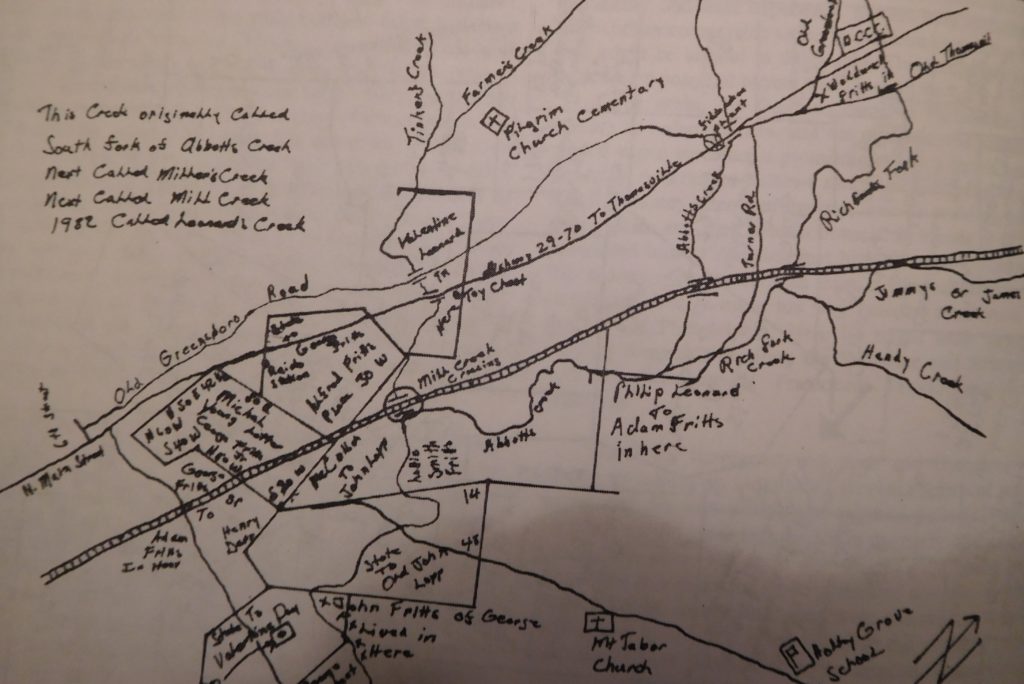
On April 19, 1775 some Massachusetts militiamen clashed with British regulars at Lexington Common and a Revolution began. Before this clash North Carolinians had maintained a relatively loyal allegiance to Great Britain. When word of the clash at Lexington reached North Carolina, open warfare seemed inevitable. The North Carolina colony was divided into six military districts for the purpose of organizing militia. The Third Provincial Congress of North Carolina, organized in August 1775, ordered the enlistment of North Carolina’s first soldiers into the Continental Army. On April 12, 1776, the Fourth Provincial Congress passed the Halifax Resolves, officially endorsing independence from Great Britain. Within two months, representatives of the Continental Congress, including North Carolinians Joseph Hewes, William Hooper, and John Penn, signed the Declaration of Independence. Wooldrich took the Oath of Allegiance to the State of NC on August 5, 1778. He is listed as Frederick Fritz and with him taking the Oath were Jacob Lopp and Michael Day, among others.
It has been written that Wooldrich, along with his two sons George and John served in the cause for American independence. Henry was still just a boy at this time. There are two pension applications relating to George and John’s service.
The statements from George Fritts given on both August 15th 1832 and on February 14th 1833 are:
State of North Carolina Davidson County. On this 15th day of August A.D. 1832 personally appeared in open Court, before the Justices of the Court of Pleas and Quarter Sessions now sitting in and for Davidson County.
George Fritts a resident of Davidson County and State of North Carolina, Seventy-nine years of age, who being first sworn according to law, doth on his oath, make the following declaration in order to obtain the benefit of the Act of Congress passed June 7th 1832. That he entered the service of the United States under the following named officers and served as herein stated. That he entered the service as a drafted militia man in the County of Rowan now Davidson, & State of North Carolina where he at that time resided (the day & year not now recollected) the Company to which he was attached was commanded by Captain Robert More [sic, Robert Moore], James Smith Major under General Rutherford [Griffith Rutherford] served five months against the Cherokee Indians when he was discharged. Entered the service again as a volunteer under Captain Lopp [John Lopp], Colonel Lytle [Lieutenant Colonel Archibald Lytle] and General Rutherford marched with the militia into South Carolina and Georgia served five months and was again discharged — was drafted and served three months under Captain Lopp, was again drafted and served three months under Captain Lopp against the Tories — was in the battle fought at Briar Creek State of Georgia, against the British when General Ash [sic, John Ashe] was defeated. Has no documentary evidence of his service. He hereby relinquishes every claim whatever to a pension or annuity except the present, that his name is not on the pension roll of the agency of any State
S/ George Fritts, X his mark
Sworn to & subscribed in Open Court 16 August 1832
[Peter Everhart & John Koontz gave the standard supporting affidavit.]
The foregoing Declaration and certificates having been returned by the War office with objections the declarant again appeared before Andrews Swicegood an acting Justice of the Peace in and for Davidson County and offered the following amendment to his declaration That his first service in the militia of North Carolina in the company of Captain Moore was for five months in the summer of the year 1776. That his second Tour of militia service was as a private soldier for five months in the company of Captain Lopp as he believes was in the summer of the year 1779 — during which time he was at the battle of Briar Creek in the State of Georgia. That his third Term of service was for three months in the light Horse or mounted militia under Captain Lopp was in 1780 — That he served for three months as a drafted soldier in Captain Lopp’s company early in the spring of 1781, that the term of his Service was the time of sixteen months. That he was born in Shenandoah County Virginia and removed to Rowan County North Carolina when very young and has lived there ever since. That no clergyman now nor at the time of making his declaration lived near him, and that none are acquainted with him.
Sworn to & Subscribed before me the 14th day of February 1833
S/ Andrew Swicegood, JP
S/ George Fritts, X his mark
[Veteran was pensioned at the rate of $53.33 per annum commencing March 4th, 1831, for service as a private for 16 months in the North Carolina militia.]
The statement from John Fritts given on May 27th 1834 is:
State of Tennessee Hawkins County. Court of Pleas & Quarter Sessions May Session 1834.On this 27th day of May 1834 personally appeared in open Court, before the Court ofPleas & Order Sessions now sitting for Hawkins County, Tennessee, John Fritts a resident of Lee County Virginia aged 72 years, who being first duly sworn according to law doth on his oath make the following Declaration in order to obtain the benefit of the act of Congress passed June 7th 1832. That he entered the service of the United States under the following named Officers, & served as herein stated.
The Applicant states that he was born in Shenandoah County in the State of Virginia in the year 1762 according to the count he has kept, that he does not know the month nor the day, having no record of his age & if there ever was one he does not know what became of it. That from Shenandoah County his Father moved when this Applicant was very small into Rowan County North Carolina where he was living when he entered the service of the United States as a volunteer in a company of Rangers under Captain John Lopp about the of February in theyear 1781. That the company rendezvoused at the County town & from thence ranged through Rowan County in quest of Tories & spying after the movements of the British, who were at that time passing through Rowan County they passed through Salisbury & crossed at the Shallow Ford of the Yadkin [River] & thence on to Guilford Court House where a battle was fought [March 15, 1781]. This applicant further states that the Company to which he belonged also ranged through other Counties that during this Term of service they were enable [enabled] to take many Tories as prisoners some of whom they hung & others they [indecipherable word] for some time & then turned them loose & that he received no written discharge from this term of service, but was dismissed.
This Applicant further states that he again entered the service as a volunteer under Captain Peter Fort [Peter Ford] for the purpose of guarding some British & Tory prisoners which had been taken in South Carolina & brought to Salisbury for safe keeping. That after guarding the British & Tories for some time at Salisbury, the British prisoners were taken towards Guilford, but this Applicant remained as a guard over the Tories & after they were relieved from this duty the Company to which this Applicant belonged ranged Rowan & the adjoining Counties to keep in all the Tories, who were continually annoying the Whigs. That this Tour of service was in the summer of 1782 as well as he now remembers & lasted to the best of his recollection at least three months, that is he was six weeks or two months guarding the prisoners & the residue of the three months ranging the adjoining Counties. This Applicant further states that he received a written discharge from this Term of service, signed by his Captain & returned home, that he took no care of his discharge & lost it he does not know how, that he never received a Commission. This applicant further states that there were no Regular or Continental troops in the service with him, therefore he knew none of their Officers. He further states that having no documentary evidence by which he can ascertain the precise periods of his service, he cannot swear positively to the length of time he did serve; but to the best of his recollection he served not less than the periods above stated making in all 6 months & for such service he claims a pension. This Applicant further states that he knows of no one now living by whom he can prove his services, but that he is well known in his present neighborhood to Obadiah Ferguson & Samuel Marion who can testify to his character for veracity & their belief as to his services during the Revolutionary War. This Applicant further states that the reason he applied in Hawkins County instead of Lee County where he lives, is that he lives near the line & that it was more convenient for him than to apply in his own County & one of his neighbors William Stapleton1 had applied & obtained his pension in Hawkins & advised him so to do. He further states that there is no Clergyman in his neighborhood. This Applicant further states that he has lived in North Carolina, Tennessee & Virginia since the Revolutionary war, & that he now lives in Lee County Virginia as he has heretofore stated. He hereby relinquishes every claim whatever to a pension or annuity except the present, and declares that his name is not on the pension Roll of the Agency of any State, or (if any) only on that of the Agency of the State of Virginia.
Sworn to & subscribed, the day & year aforesaid.
S/ John Fritts Signature
S/ W. B. Mitchell, D. Clk.
[Samuel Marion & Obadiah Ferguson gave the standard supporting affidavit.]
[p 9: On November 6, 1837, applicant applied for a transfer of his pension benefits to Monroe County, Indiana, to which he had moved to at the request of his son, Henry Fritts who testified as to the identity of his father. Henry signed his name “Henry Frits.”] Signature
[p 22: In 1843, Fritts moved back to Lee County, Va., and applied to have his pension payments transferred to that State.]
[p 16: Letter sent from West Liberty and dated January 26, 1859 addressed to the War Department and signed by S. R. Fritts makes reference to the correspondence grandmother still being alive and invalid and claiming pension money on her behalf. Her name is not stated. . The file contains no other documentation referring either to the 1 William Stapleton R10064 correspondent or the widow of the veteran.]
[Veteran was pensioned at the rate of $20 per annum commencing March 4th, 1831, for 6 months service as a private in the Virginia [sic North Carolina] militia.
Death of Woolrich Fritz
After the Battle of Guilford Courthouse in March 1781 many Patriots returned to North Carolina which became a battleground for an ongoing civil war between local Patriots and Tories. One particular Loyalist that terrorised the region during this time was David Fanning. Fanning spent much of his time recruiting loyalist sympathizers to serve in militias. The Loyalist militias would often conduct raids with fewer than 12 men. Fanning and his militia would wreak havoc on the North Carolina backcountry. On the evening of November 2, 1781 Woolrich was shot in his home. His neighbor and friend Valentine Leonard was also shot that night in his home. It’s assumed that Fanning or some Tories from his militias were responsible for the shootings. Woolrich died that night while Leonard died from his wounds on November 13th. In the following excerpt Jacob Leonard, the son of Valentine Leonard provides some insight into this tragedy in his 1834 pension statement:
He the said Jacob Leonard further states that he was drafted in the first of the fall of 1781 as well as he now recollects and entered the service as a light horseman on the first of October 1781 under the command of Captain John Lopp, Lieutenant Joseph Cunningham or Cunigam no other officer recollected at that time. They then marched for Wilmington North Carolina & before he reached Wilmington they passed Colonel Butler [John Butler] & his men, and also General Rutherford [Griffith Rutherford] in his Regiment, and then arrived at or near Wilmington or perhaps a little North of said town where they remained some time under Major Smith [probably Colonel Robert Smith] & Major White [perhaps William White] of the light horse troops & from thence he marched with the said Company to Fayetteville after the British had vacated [evacuated] the post of Wilmington on the account of Lord Cornwallis having previously surrendered. And from Fayetteville he marched up through the State in order to attack Colonel Fannon [sic, David Fanning] who was at the head of a band of Tories who murdered his the said Jacob Leonard’s father and Frederick Fritz in the time of the said Jacob Leonard’s absence from home on this tour and also they rifled the houses &c. The said Jacob Leonard further states that he and his company of light horsemen met with said Fannon and men and had a small skirmish in which they put the Tories to flight. And further states that he and his company marched up towards home where he and the other soldiers were discharged by Captain John Lopp after the second tour of three months or more making in the whole of his service six months or upwards, but he states that he will pass it for only six months service therefore he claims only for that length of time. He further states that he was not in any battle of great consequence only one about two miles of Wilmington at the brick house [November 15, 1781] so called and that with Fanning & his gang of Tories.
The bodies of Woolrich Fritz and Valentine Leonard were buried side by side in the Pilgrim Church Cemetery. A sixteen foot monument was placed at their graves in 1896 “in memory of two courageous Patriots of the Revolution.” Fanning nor any other Loyalists were captured or held responsible for the murders of Woolrich and Valentine. A legislative act in North Carolina in 1783 which granted pardons to former Loyalists specifically exempted Fanning from its terms, along with only two other men. Fanning died in Digby, Nova Scotia in 1825.

Henry Fritts
From Rowan, NC to Roane, TN
Henry Fritts was 11 years old when his father was killed. It has been written that his mother Janet remarried a Whittaker. Regardless, after his father was killed Henry was bound out to a farmer named Valentine Day. Orphans and children in families too poor to care for them were often apprenticed or bound out to a trade. Henry remained with Mr Day until he reached his 21st birthday and was to be given fifteen specie at expiration of his time with Mr. Day. Henry married about 1791. It has been suggested that he married his wife in the Pilgrim Church. It has also been recently suggested that Henry’s first wife’s name was Jessie Forest Broadway.
On November 27, 1793 Henry acquired 350 acres of land in Rowan County via land grant (#2209) from the state of North Carolina, and later in Davidson County on Abbotts Creek. Henry and his first wife had several children in Rowan and Davidson counties in North Carolina. Their names were John (1792) George (1794-1798) Christina (1799) Jacob (1800) Peter (1801) Phillip (1803) David (1804) Catherine (1809). During the next 18 years or so Henry was involved in several land transactions in Rowan and Lincoln Counties with the last being on November 28, 1810 when Henry sold 2 tracts to Christian Brinkle then moved his family to Roane County, Tennessee where he purchased 161 acres of land.
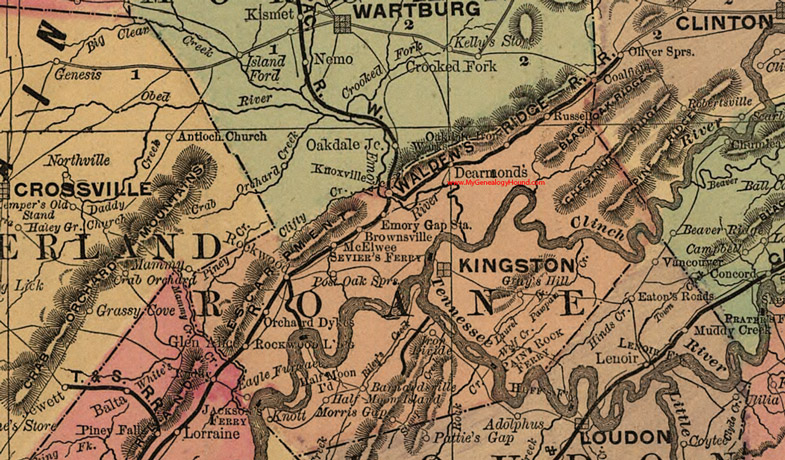
The Roane County land purchased by Henry was located between Clinch River and Buttermilk Road on or near Paw Paw Creek. TVA maps show the Indian town of Paw Paw to have been located in a huge bend in Clinch River at a point across the river and slightly down stream from the Fritts farm. The Buttermilk Road was either part of or parallel to the Great Stage Road built from Campbell Station in Knox County to Kingston in the 1790’s. Soon two more children were born. These were John Henry (1813) and Isaac (1816). Jessie Forest Broadway died in 1830. Five years later Henry married Patsey Liles. Henry and Patsey had two children, Jeremiah (1836) and Ransom (1839), however, during or soon after the birth of Ransom Patsey died. Henry again remarried, this time to Ann Turnbull. They did not have any children. Henry Fritts died between 1842 and 1851. It’s suspected that Henry was buried in the Pleasant Hills Baptist Church Cemetery north of Lenoir City, TN.
Jacob Fritts

Jacob Fritts (1800-1878) was about 11 years old when the family moved to Roane County, Tennessee. He grew up with many siblings and likely spent much his time working the Fritts farm and spending time doing what kids do in the early 1800s. On December 23, 1818 Jacob married 15 year old Sally Sexton. According to genealogy records Jacob owned and farmed property on Caney Creek in Roane County. An 1850 Census noted Jacob as being “Owner of the Farm” and being in “Agriculture” on 30 acres of land valued at $150. He owned two horses, two milk cows, two oxen, two sheep, 18 pigs, and 600 bushels of Indian Corn. It has been noted that Jacob owned Lot 8 on the north side of Race Street (now Main Street) in Kingston, along with other lots in the area, which were sold off by 1870. A great-great grandson of Jacob noted that he also owned a furniture shop in Kingston where he manufactured fine furniture such as tables, chairs and beds. Jacob and Sarah had 11 children. Two children died within a year of being born, they were Peter and Sarah J. An 1850 Census shows the children still living on the farm at that time. These were Jacob S. (20), Henry (17), John (14), Catherine (12), William (9) and Joseph (5). Their oldest children Isham, David, and Mary Ann had moved away by this time.

The Fritt’s in Roane County continued to work and new generations were born. When the American Civil War began in 1861 many men from Roane County volunteered for service. Roane County, like many East Tennessee counties, was largely pro-Union. When Tennessee voted on the Ordinance of Secession on June 8, 1861, Roane County residents voted 1,568 to 454 in favor of remaining with the Union. The Fritts family was with the majority. Two of Jacob’s children were among the men that volunteered for service in the Union Army. These were John C. Fritts (1862 Union Private & Wagoner in 5th Regiment-Company B. Tennessee Infantry.) and William Nelson Fritts (pictured below – 1862 Union Corporal in 5th Regiment-Company B. Tennessee 5th Infantry.).

Other Fritts relatives in the area also volunteered with the Union Army as well. It has been written that the Fritts families in eastern Tennessee during the Civil War were die hard Unionists.
Henry Fritts aka Rev. Henry Fritts
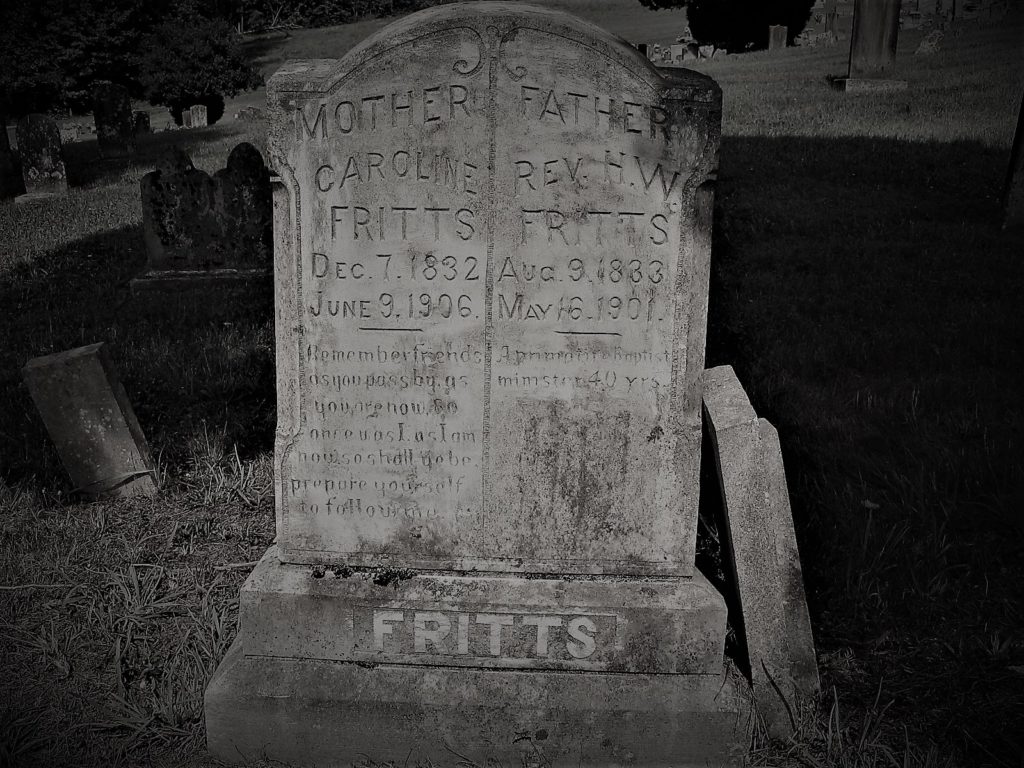
Henry was the fifth child of Jacob and Sally Sexton. He was born on August 9, 1833 in Roane County. In 1850 the 17 year old Henry was still living with his parents Jacob and Sally and likely spent his time working the farm. On February 8, 1853 Henry married Caroline Johnson who was born on December 7, 1832. Henry was likely studying, or was at least drawn to, religious service. In 1860 he was listed as being a farmer and baptist minister in Roane County. Rev. Henry and Caroline eventually had nine children. One of his children was Horace Maynard Fritts. In 1870 and 1880 Rev. Henry was still listed in the census as a minister, however, in August of 1874 Henry also spent some time as Postmaster at the Union Cross Roads USPS location in Roane County. On July 19, 1895 an article ran a sub-headline, “Minister Attempts Suicide.” Apparently in Harriman, Tennessee Rev. Henry attempted suicide by “throwing himself in front of an engine on the C., H & I railroad as the train came in from Brushy mountain. The minister being thrown aside, he attempted to get under the wheels of the train, but was thwarted. He is now under the watchful care of friends. Bad health and business troubles are alleged as the cause of his rash act.”

The 1900 census shows the 66 year old Henry living in Loudon County and does not list an occupation. Rev. Henry W. Fritts died on May 26, 1901. His gravestone notes him as a “Primitive Baptist Minister.” He was laid to rest in Poplar Springs Cemetery. Caroline Fritts passed away on June 9, 1906 at age 73. She was living at 120 Logan Ave. in Knoxville.
Horace Maynard Fritts
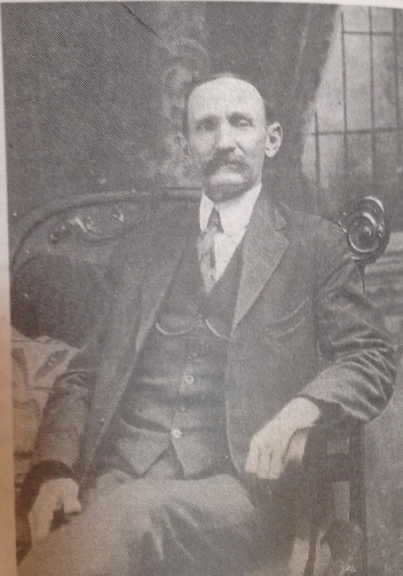
Horace Maynard Fritts was born February 15, 1857. He was the third child of Rev. Henry Fritts and Caroline Johnson. There’s no record of him having served in the military, nor has anything been written about his childhood growing up in Roane County, Tennessee. In 1880, at 23 years old Horace appeared in the census as a carpenter in Roane County. It has been written that Horace was a “very fine carpenter, bridge builder, coal tipper builder, and often held the position as boss carpenter. He built many of the homes that miners lived in at the coal camps.” Having taught his children the trade it was said that “while Horace would build houses two of his sons, Frank and Herbert, would build the outhouses. They became fine carpenters also. Horace worked mostly at the Windrock, Piedmont and Petros coal camps in Tennessee, but would provide his services wherever they were needed.

Horace married Mary Ann Fritts on March 16, 1884 in Oliver Springs, Tennessee. They had seven children and they all grew up in and around Oliver Springs. Some time was also spent living in Tuppertown “in a red house with no porch on the front, close to Ben Diggs house.” Horace’s occupation around this time is “Carpenter Fireman in Coal Industry.” On March 14, 1913 Mary Ann Fritts passed away after a battle with cancer. Burial services took place at Oliver Springs Cemetery.

After Mary’s passing Horace was introduced to Malinda Cheeks Fairchild by Rev. William M. Fritts. Malinda was a recent widow whose husband of 19 years James Fairchild had passed away. Malinda and James did not have any children. Horace and Malinda were married in Anderson County, Tennessee on April 8, 1916 by Rev. William Fritts. Soon after getting married Horace and Malinda moved to St. Charles, Virginia, a small coal mining town. The town was a center of commerce for the mining camps and communities that surrounded it during the coal boom of the early twentieth century. Horace and Malinda lived in a community called Darbyville, just north of St. Charles on Gin Creek. It’s likely that Horace was offered or found carpentry work here with the coal mines, such as the Darby Coal Mining Company who around 1914 were working a coal mine just north of Darbyville. While living in Darbyville Malinda gave birth to two sons, Maynard James Fritts on October 20, 1917 and Horace William Fritts on November 10, 1918.

In 1923 it appears Horace Maynard moved the family to Fountain City, Tennessee, just north of Knoxville. Horace worked as a carpenter and the family lived at 709 Maple Ave. In 1924 Horace worked at Worsham Brothers, a Knoxville based construction company. One of the big projects Worham Brothers was working on at that time was the First Baptist Church in Knoxville at 510 Main Street. Ground was broken for the church in 1923 and required more than 150 workers to build. Sometime after 1925 Horace moved the family down to Knoxville. In 1930 they lived at 516 Galbraith, in 1932 at 326 W. Vermont Ave., in 1934 at 376 W. Massachusetts Ave. in 1935 at 1638 Grand Ave.
On September 23, 1935 Malinda was admitted to the Medical Arts Building in Knoxville. After a month Malinda died at 6:00am on October 24, 1935. Her cause of death was Mitral Regurgitation, with Cardio Nephritis as a contributing factor. Malinda was 58 years old. Funeral services were at Oliver Springs Cemetery on October 16, 1935.

Just two years later Horace Maynard Fritts was admitted into the Knoxville General Hospital on December 19th, 1937. He died only a few days later at 9:55am on December 22, 1937 at 80 years old. The principle cause of death was hypostatic pneumonia and chronic nephritis, with prostatic hypertrophy being a contributing factor.

At his time of death Horace was living at 1807 N. Liberty St. in Knoxville. His son from his first marriage Herbert Fritts was the informant on the death certificate and gave 1807 N. Liberty as his address as well. Funeral services took place in Oliver Springs on December 24th.

Maynard James (“Jimmie”) Fritts
Maynard James Fritts was born on October 20, 1917 in St. Charles, Virginia to Horace Maynard Fritts and Malinda Cheeks Fritts.

Horace and Malinda were living in Darbyville, one of the small mining communities just north of St. Charles on Gin Creek. Horace was a carpenter at the time and Malinda was noted as a “Housewife.”

There is no detailed information about the life of Maynard James Fritts, particularly his short time in Darbyville or growing up in Fountain City and Knoxville.
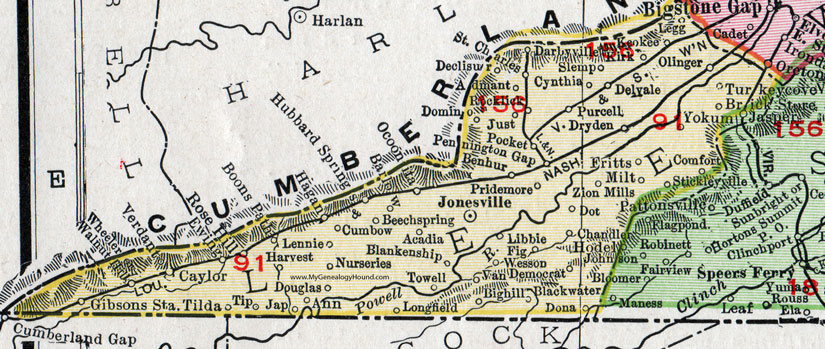
Two of Maynard’s sons noted that Maynard briefly attended Powell High School in Knoxville, but did not graduate. Maynard’s mother Malinda died on October 24, 1935. Maynard adored his mother and was devastated by the loss. Maynard’s father Horace died on December 22, 1937.
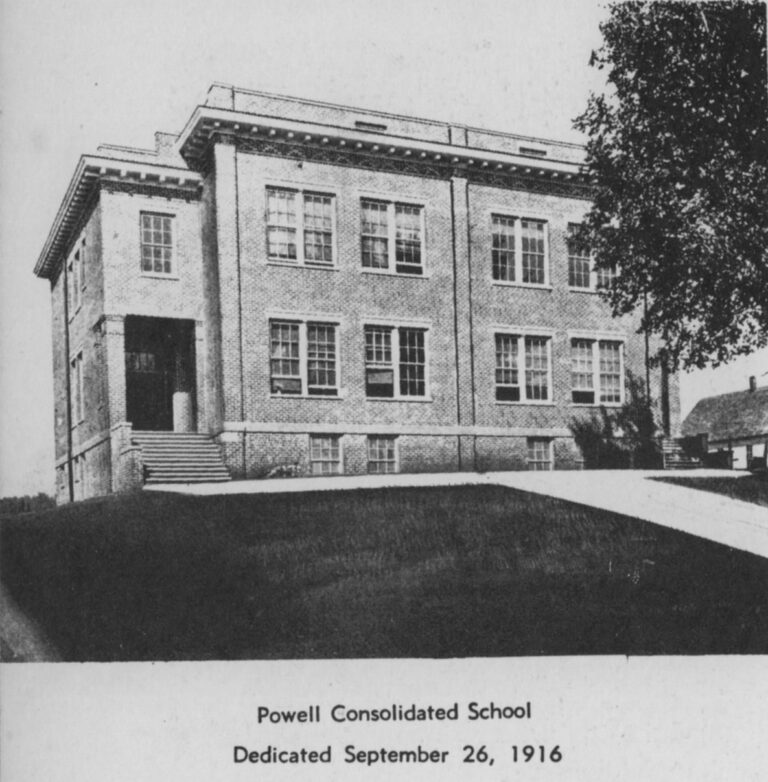
That same year, according to two sons of Maynard, when Maynard was about 20 years old he was sent to Brushy Mountain State Penitentiary for running moonshine. He escaped a short time later and relocated to Toledo, Ohio where he had family.
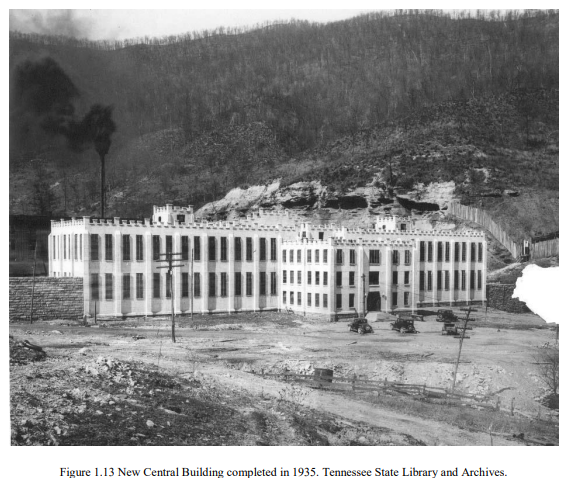
In 1938 a Marriage License application was submitted on July 9 in Ohio by Maynard “Jimmie” Fritts of Toledo, Ohio and Gladys J. Whalen of Bowling Green, OH. The marriage was solemnized the same day by E.E. Bailey of Bowling Green, Ohio.
When Maynard was registered for service his name was edited and changed from Fritts to Fritz, something he didn’t correct considering his recent past. All of the children of Maynard, his grandchildren and great-grandchildren spell their last name as Fritz.
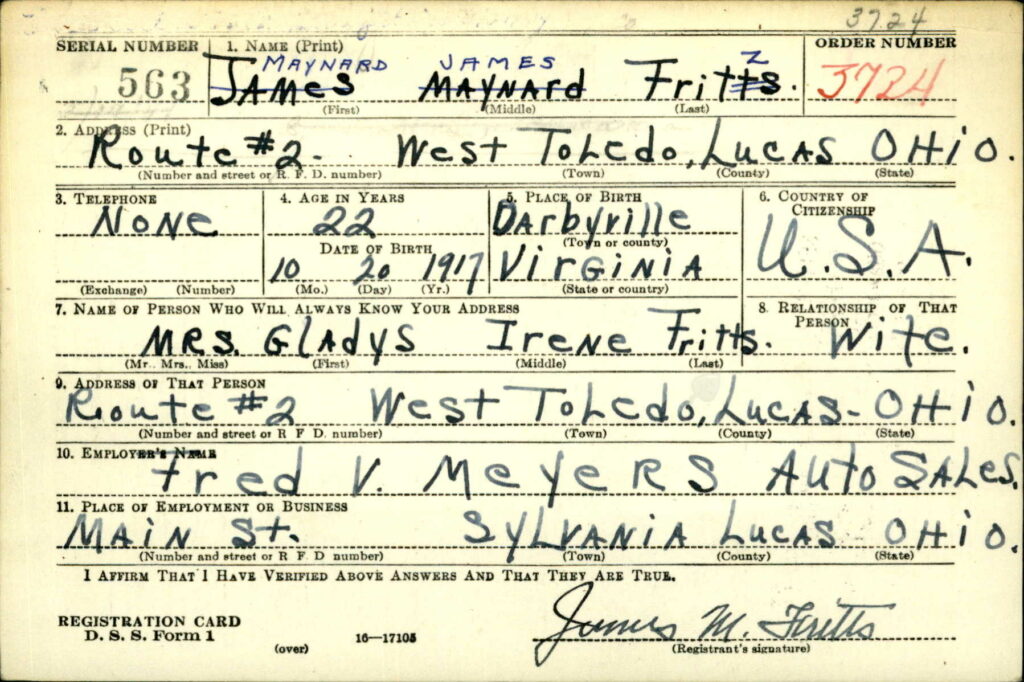
Maynard’s WWII Draft Card was filled out on October 16, 1940. He was 22 years old. The card notes that Maynard stood 5’10’’, weighed 154lbs, had blue eyes, brown hair, and was light complected. The card also notes that Maynard was working at Fred V. Meyers Auto Sales on Main Street in Sylvania, Ohio. Maynard and Gladys were living on Route 2 in West Toledo, Ohio.
Maynard and Gladys had five children. Edward James Fritz (1939), Charles William Fritz (b1943) Franklin Eugene Fritz (1940) Roger Dale Fritz (1948), and Tommy Lee Fritz (1947).

Maynard James Fritz died on October 3, 1971 at St. Vincent Medical Center in Toledo, Ohio. Maynard was laid to rest at Toledo Memorial Park Cemetery. Gladys Fritz died on January 12, 2012.
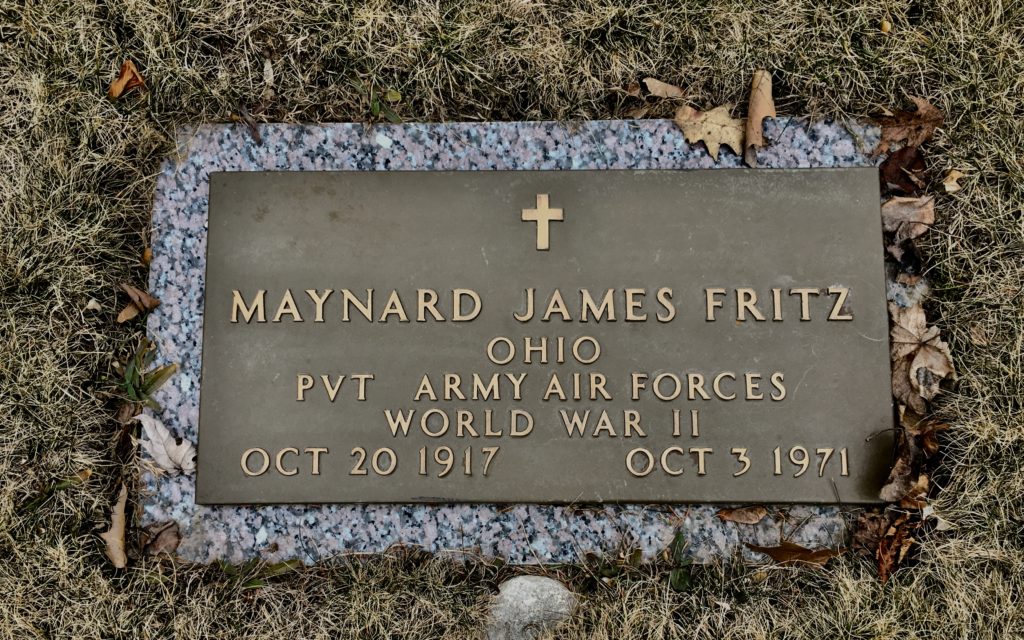
Resources
- The Fritts (Fritz) Family Heritage: A Historical, Genealogical, and Biographical Record of the Fritts (Fritz) and Allied Families from October 30, 1738, Gregory Alan Fritts, 1979.
- The Perkiomen Region, Past and Present, Vol. 2. Sassaman Dotterer, Henry. Perkiomen Publishing Company, 1900. p.152 “Old-Time News – Sailing of Emigrant Ships” (Link) Keywords: Goeree; July 18.
- The Emigration Season of 1738: Year of the Destroying Angels. Wust, Klaus. Beyond Germanna Vol. 10, No 1, January 1998. (Link)
- Congressional Record: Proceedings and Debates of the … Congress. U.S. Government Printing Office, 1928. Vol. LXIX-Part 2, Jan. 9 – Jan. 31. 1928. P.1151-2294. (Link) (see p.1324 “German Migration to America”)
- The Palatine Wreck: The Legend of the New England Ghost Ship Farinelli, Jill. 2017. (Link)
- Pennsylvania German pioneers : a publication of the original lists of arrivals in the port of Philadelphia from 1727 to 1808. Strassburger, Ralph Beaver. Pennsylvania German Society, 1934. (Link) (Link2)
- Chronicles of the Scotch-Irish Settlement in Virginia: Extracted from the Original Court Records of Augusta County, 1745-1800, Volume 1 Chalkley, Lyman.. Augusta County (Va.). The Commonwealth Printing Company, 1912. (Link)(Link2)
- A History of Rowan County, North Carolina. Rumple, Rev. Jethro. (1881) (Link)
- The Heritage of Davidson County, 1982. Genealogical Society of Davidson County, North Carolina. Lexington, N.C. : Genealogical Society of Davidson County.
- “Minister Attempts Suicide” The Evening Republican. Greenfield Indiana. July 19, 1895. Vol 1. No. 203. P1 (Link)
- Historic Sketch of the Reformed Church in North Carolina. Philadelphia, Pa. Publication Board of the Reformed Church in the United States (Link)
- First Church, Davidson County : a history of Pilgrim Evangelical and Reformed Church (United Church of Christ), Lexington, North Carolina, 1757 to 1957. Pilgrim Evangelical and Reformed Church. 1957. (Link)
- Southern Campaigns Revolutionary War Pension Statements & Rosters (Link1) Website (Link2) George Fritts (Link3) John Fritts (Link) Jacob Leonard
- Tennessee in the war, 1861-1865; lists of military organizations and officers from Tennessee in both the Confederate and Union armies; general and staff officers of the provisional army of Tennessee, appointed by Governor Isham G. Harris. Wright, Marcus Joseph, 1831-1922 (Link)
- Horace Maynard schoolhouse article/image from Sequachee Valley News. (Sequachee, Tennessee). May 14, 1896. p2 (Thanks Gina!)
- Horace Maynard Fritts obituary article/image from The Knoxville Journal (Knoxville, Tennessee). Dec 23, 1937. p9 (Thanks Gina!)
